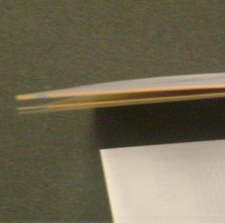Cut & Stack Labeling Nightmares Part 2
July 8, 2015
We’re back – with some cut and stack vengeance.
A few weeks ago, in Cut & Stack Labeling Nightmares Part 1, we shared with you the tribulations of label curl, label flagging, size variation and label scuffing. Yet there are a few other cut and stack labeling nightmares that may be lingering amongst your label lines.
If that’s the case – fear no more. We’ve gathered a few more cut and stack label tips and tidbits to help tackle some not-so-flattering label culprits.
Tearing
You probably have a good idea of what we mean by label tearing. But just to be sure, we’re not talking about labels that are provided to you all torn up. That’s just poor quality service that you should be running from! We’re talking about label tearing that occurs on your labeling lines. Label tearing is usually the result of basket fingers that are either too tight or picker fingers that are miss-aligned. This causes increased pressure on the label which ultimately tears it. However, too much adhesive, condensation or line lube can also result in tearing.
The most important questions to ask yourself are where and when are your labels tearing? Start by adjusting your equipment, whether it’s the basket fingers or picker fingers, to see if this reduces or eliminates the tearing. If not, turn down adhesives and reduce the moisture on your labeling line. If your problem persists, you may want to look at long-term solutions – such as using bottles with a deeper label panel or using paper with a higher wet strength. A deeper label panel on your container helps eliminate label to label contact on the lines which may be the cause of your tearing.
Blocking
Ever see label edges that seem to be fused together within a bundle of cut and stack labels? This is what is referred to as label blocking. When a label supplier is using dull dies or dull knives during label production it often results in label blocking. A supplier may have also strip cut the labels before the ink was dry, causing the labels to stick together. If your labels have a notch maker on them (think beer labels that show which month the beer was brewed in), blocking may have occurred when cutting the notch. Another possibility is the labels got wet and as a result start sticking together.
Make sure your provider inspects their dies and knives to confirm that any dullness or nicks are not causing the blocking issue. It’s common for providers to have a spare die in case of a die flaw. They also have the ability to re-sharpen dull dies and knives. You’ll also want to be sure you are fanning your bundles before use. Remember that your provider is removing any air between the labels to make sure that cuts are accurate. Fanning your labels before use helps separate labels that may be stuck together because of this. It’s also important to keep your labels in their original packaging until you’re ready to use them on your line. Doing so will eliminate the chance of moisture or condensation-triggered blocking. The only exception to this rule are IML labels, which are often staged in a controlled environment 24 hours prior to running to increase efficiency.
Inversion
Turn around! No, really! Inverted labels are the upside-down or backwards labels that you find within a bundle. This is caused by either supplier error (lift wasn’t turned the right direction when cutting, building full bundles from partial bundles, etc.) or you’re mixing in partial bundles after change overs on the lines.
One way suppliers can assure your labels are always facing the right direction within a bundle is to add collation marks. Collation marks are small markings on the edge of your labels to show where the labels line up. Once you receive the bundle you should be able to confirm all the labels are in order because you’ll be able to see the collation marks matching up across the bundle.
Poor Adhesion
Nothing is more frustrating than labels that have trouble adhering to your container. Poor adhesion, or labels that are not sticking well or falling off containers, can be the result of a variety of issues. The first of which is excess cold-end glass treatment. Other likely causes are paper and adhesive miss-match, adhesive trouble or paper problems.
To understand more about the poor adhesion, first try different labels to double-check for container and adhesive quality. Also try labels from different production dates or different paper roll numbers from the same production date. This will help narrow down the realm of possible causes. If the problem persists, be sure your supplier is actively looking for a solution.
Well, there you have it. Just a few cut and stack labeling nightmares that are no-more. Remember, we’re here to help with any cut and stack (or any label type, for that matter) problem that you may be faced with. That’s what we have those handy technical services reps for.



